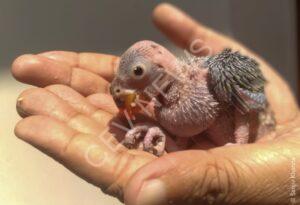This is my first step in life
While attending bird rescue calls or during visit for a bird rescue I come across a typical problem. Many people and bird lovers catch the birds in their first step of life or in its first flight. Many of the bird like pigeons, doves, babblers, bulbuls, sparrows and tailor birds make their nest close to human habitat. As a natural process parents rear the chicks in nest for a particular time. The most important time of their life comes, when every young bird leaves the nest. At this course of time they see the nature for first time and it takes time for them to adjust to their surroundings. Some of them also fell down on the ground or perch on the lowest branch of a tree. This is most critical time of their life when life is at risk. With the help of parents around, these young birds pick up quickly and start following parents in maximum cases. At this stage of time many of bird lovers use to capture these innocent birds for sake of rescue.
What should we do at this stage? This is a very common question. I always recommend to see the age of chick first. If
the chick is able to take small flights, then never try to catch it. Just stay away and let the parents take care of young bird.
What most you can do is to keep any dog or cat away from these innocents. Nature is very powerful and these chicks
adjust to their habitat quickly.

In other case if the chick is not having properly developed wings and not able to fly, we must try our best to find the bird nest around. This is quite obvious that the chick without wings must have fallen from a close location of nest. In
almost all the cases I have seen parents adopting chicks replaced in their nest. This is not right to say that, bird parents not accept the chicks when touched by human. Above all, please avoid feeding water to chicks in this stage
unless it looks very essential.

Young chicks in their first flight On other hand there are some birds like lapwings, francolins and quails etc that mostly make their nests on ground. After hatching, their chicks immediately leave the nest and start running in ground here and there. Many curious people and rescuers catch these chicks for rescue purposes. Please remember, feeding these young chicks is more or less an impossible task. On other hand you can always find their
parents making calls around. Please never try to rescue young birds at this stage and leave them as such. These young birds should only be rescued if they are found injured and are not able to walk or fly. Please always avoid getting close to bird nests around human habitat. Birds like sunbirds, bulbul, babbler and tailor bird can make a nest in your garden plant or in a pot inside your house premises. Pigeons and doves prefer making nests in windows, air
conditioners and other shaded outer extensions in our localities. Never try to destroy any nest with eggs or chicks.
Please always try to keep back chicks at this stage in the nest.

These are ground living birds and movement of chicks in ground is a natural process. Never try to rescue them in this stage. From the foregoing observations, this is clear that, rescue of a young bird chick is a sensitive process. We must not keep them with us for sake of rescue. Natural rearing of these chicks is not possible in captivity. We must try to either leave them with their parents or replace them in nest around. Let us save birds to save earth.
Er Sanjiv Khanna
Student of Ornithology at BNHS Mumbai and a bird rescuer. Global e-birder of month Oct 2019 by
Cornell Lab of Ornithology. Founder, Aashray a bird shelter for stray and injured birds
Edited By- Dr.Kanav Khanna, June, 2020, Jalandhar, Punjab. 9814064303
You can Join telegram group of CEV INDIA group for more details and information
https://t.me/joinchat/FOGm2kcLrfYoZF27bEax1Q


